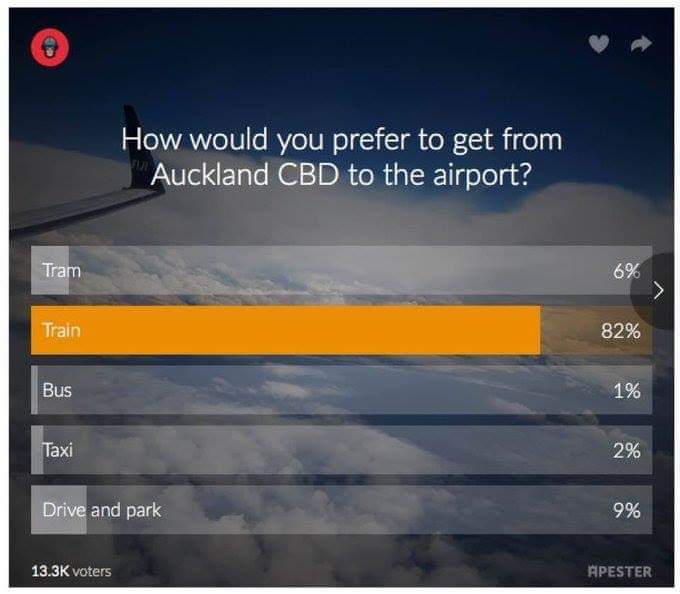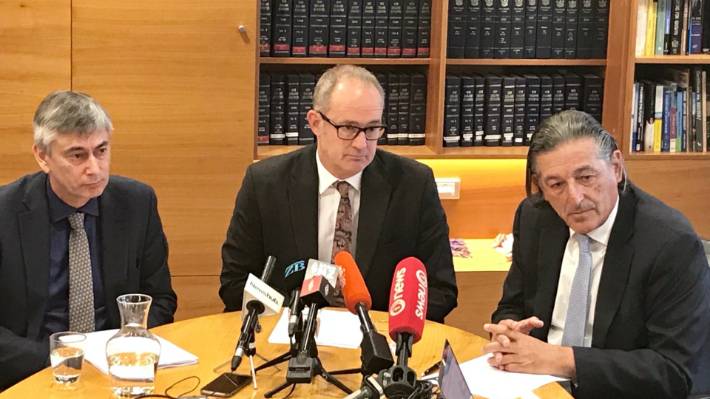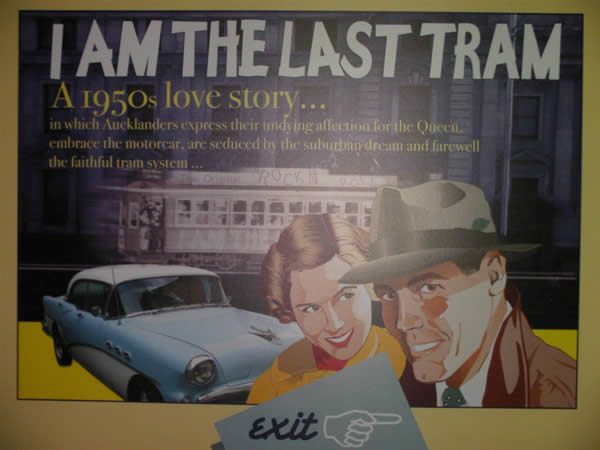Conflicts of Interest: Twyford’s light rail project based on questionable advice
Transport Minister Twyford’s defence of his unpopular light rail to the airport plan (Dialogue 25 October 2019) was light on argument but heavy on references to ‘experts’. The Minister will need to do better than this to convince Aucklanders that he is right to exclude the electric train option. In a recent NZ Herald online poll, of 13,300 readers, 82% indicated they would prefer to take a ‘train’ to the airport, 9% preferred to ‘drive and park’ while only 6% opted for ‘light rail’ (trams). This is an extraordinarily resounding response and should give be giving the government pause.

NZ Herald Digi-Poll Nov 2018
82% of those polled prefer trains to the airport while on 6% preferred trams.
Mr Twyford’s proposed 24km tramline to the airport, or to Mangere as it has been rebranded, via Dominion Road while still not yet having a supporting business case is presently estimated to cost $3.7b. While it is accepted that building the tram line will be lengthy and disruptive, especially to people living or trying to run a business near it, the finished product is likely to come with another set of impacts. This is because Mr Twyford is predicting light rail on Dominion Road will carry ‘as many people as a four-lane motorway’ but furthermore he is selling light rail as catalyst for intensive development in that corridor – ‘a magnet for investment’ as he puts it. However Mr Twyford’s threats to shut down public opposition to any development by overriding the Unitary Plan (and therefore the Resource Management Act) has not gone down well on Dominion Road or with residents of nearby leafy streets. They are starting to view Mr Twyford’s scheme as a threat to their heritage neighbourhoods. Rather like the minister’s Kiwibuild homes ‘not being for people on low incomes’, his light rail service with only 8 tram stops along the Dominion Road corridor instead of the present 20 bus stops, is clearly not designed for the convenience of public transport users – whether they are airport passengers (too slow) or local residents (not enough stops). The problem is Mr Twyford’s scheme is trying to deal with two separate public transport problems at the same time, serving Auckland Airport whose throughput is predicted to grow to 40m passenger movements by 2030 and dealing with growing congestion on the isthmus. However way you look at it, it’s a suboptimal solution for both.

Transport Minister Twyford with his two (official) principal transport officials. At left NZTA CEO Fergus Gammie & at right NZTA chairman Michael Stiassny – both Gammie & Stiassny soon after resigned or were pushed out. (Stuff).
Given the Minister’s heavy reliance on ‘experts,’ (he referred to them four times) it is only fair to ask who are these experts? Light rail experts are not to be found where NZ transport ministers usually get their technical advice, not in the Ministry of Transport, nor NZTA (despite the latter being charged with delivering the project). And as a former director of Auckland Transport, I can attest to the dearth of light rail experts in that organisation which is the source of Mr Twyford’s scheme. In 2016 AT suddenly changed course rejecting the 2011 ‘South-Western Airport Multi-Modal Corridor Project’ (which had been supported at the time by AT, Auckland Council, Auckland International Airport Ltd, NZTA and KiwiRail) and its recommendations for a heavy rail link to the airport from Onehunga and Puhinui. AT is itself heavily reliant on outside consultants, especially Jacobs NZ whose controversial claims and costings in its 2016 report was the catalyst for the policy change. There has been recent criticism in the media of the dodgy methodology of AT’s business cases for certain cycleways. However I imagine these are squeaky clean and the epitome of objectivity compared to the Jacobs’ report. The other sources of advice to the minister, and his associate minister Julie-Anne Genter, appear to be employees of the Australian-based consulting firm MR Cagney and the activist bloggers of the advocacy group ‘Greater Auckland’, (many of whom actually appear to be the same individuals and one of whom is Ms Genter’s partner).
Despite the minister’s airy references to ‘experts’ it is the worrying lack of contestable advice that is his scheme’s greatest weakness. Remarkable too is the lack of any ministerial interest or curiosity about Melbourne which has the biggest light rail system in the world and which is now building a heavy rail connection to Melbourne International Airport.
Time was when transport projects of this cost and scale were the subject of widespread public debate and public input but in recent years the statutory Regional Land Transport Plan and the Regional Public Transport Management Plan with its public input processes have been marginalised by the top-down and informal ‘ATAP’ (‘Auckland Transport Alignment Process’). ATAP has become the means by which the government-of-the-day imposes on Auckland what it wants – with no opportunity for ratepayer, taxpayer or travelling public input. Twyford’s tramline to Mangere is actually the outcome of a ‘refreshed’ ATAP – his ATAP – replacing the previous government’s 2016 ATAP. But Mr Twyford needs to be reminded we live in a democratic society. Unless the minister stops acting as some sort of transport ‘Czar’, trying to impose his will on an increasingly sceptical public, then the 94 % of Aucklanders opposed to his light rail scheme, are likely to stay opposed. As with the backlash against the nation-wide regional fuel tax, (originally designed to augment government funding for Auckland’s light rail), halted by a ‘captain’s call’ from the prime minister, Mr Twyford’s $3.7b ‘City Centre to Mangere’ light rail scheme is likely to come with political consequences.
This article was published in the NZ Herald and on the Whale Oil and Daily Blog websites.



